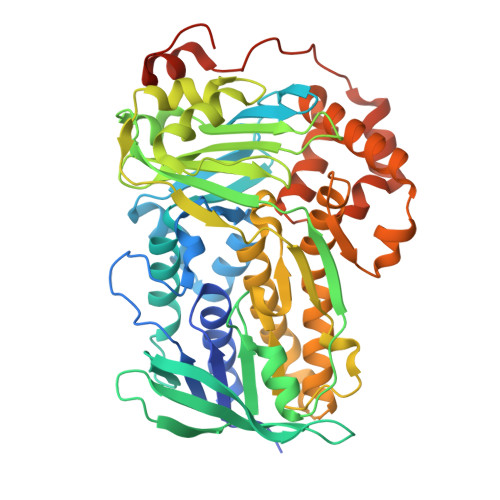Mechanistic and molecular insights into iterative triepoxidation catalyzed by monooxygenase MonCI using a natural substrate analog.
Deng, Y., Guan, Y., Xiao, H., Kang, Y., Dang, D., Jiang, G., Wang, Q., Yang, Y., Cheng, L., Zang, Y., Zhang, S., He, W., Hotta, K., Liu, J.Q., Yang, Z., Chen, X.(2025) Int J Biol Macromol 311: 142876-142876
- PubMed: 40203940
- DOI: https://doi.org/10.1016/j.ijbiomac.2025.142876
- Primary Citation of Related Structures:
9IWV, 9UDB, 9UDD, 9UDE - PubMed Abstract:
Monensin, a polyether antibiotic produced by Streptomyces cinnamonensis, is synthesized through a series of stereospecific epoxidations orchestrated by the FAD-dependent monooxygenase MonCI. This study presents the crystal structure of MonCI in complex with a substrate analog, farnesyl acetate, which undergoes in vitro epoxidation at all three olefinic sites by MonCI. Additionally, we have solved the crystal structures of MonCI in complex with mono- and bis-epoxide intermediates. Structural analysis revealed that the interactions between MonCI and its substrate are predominantly hydrophobic, with residue Y208 playing a crucial role in substrate translocation. Computational modeling emphasizes the importance of FAD proximity to each olefinic group for efficient catalysis, providing insight into the mechanistic pathways for the first, second, and third epoxidations. Notably, when combined with electrochemical techniques, the yield of tri-epoxide farnesyl acetate reached 94 %, surpassing traditional enzymatic catalysis. This work not only elucidates the catalytic mechanism of MonCI but also underscores its potential as an effective biocatalyst for processive epoxidation in organic synthesis.
- Key Laboratory of Synthetic and Natural Functional Molecule of the Ministry of Education, College of Chemistry and Materials Science, Northwest University, Xi'an 710127, China.
Organizational Affiliation:



















